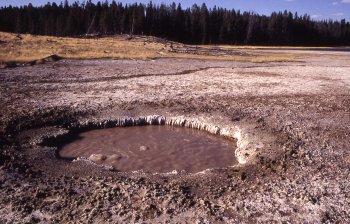acidophiles

An acidic mud pot in Yellowstone Park – home to the acidophile Sulfolobus acidocaldarius. Credit: US National Park Service.
Acidophiles are microbes, including certain types of bacteria and archaea, which thrive in acidic environments, such as sulfuric pools, where the pH values are in the range 1 to 5. They are a type of extremophile. Because high intracellular acidity levels would destroy essential molecules, such as DNA, acidophiles have evolved the ability to pump hydrogen ions out of their cells at a constantly high rate. The result is a mildly acidic internal pH of about 6.5 compared with a typical external pH of about 2.
Several algae, such as the unicellular red alga Cyanidium caldarium and the green alga Dunaliella acidophila, are exceptional acidophiles both of which can live below pH 1. Three fungi, Acontium cylatium, Cephalosporium sp., and Trichosporon cerebriae, grow near pH 0. Another species, Ferroplasma acidarmanus, has been found growing at pH 0 in acid mine drainage in Iron Mountain in California. These polyextremophiles (tolerant to multiple environmental extremes) thrive in a brew of sulfuric acid and high levels of copper, arsenic, cadmium, and zinc with only a cell membrane and no cell wall. Compare with alkaliphiles.


